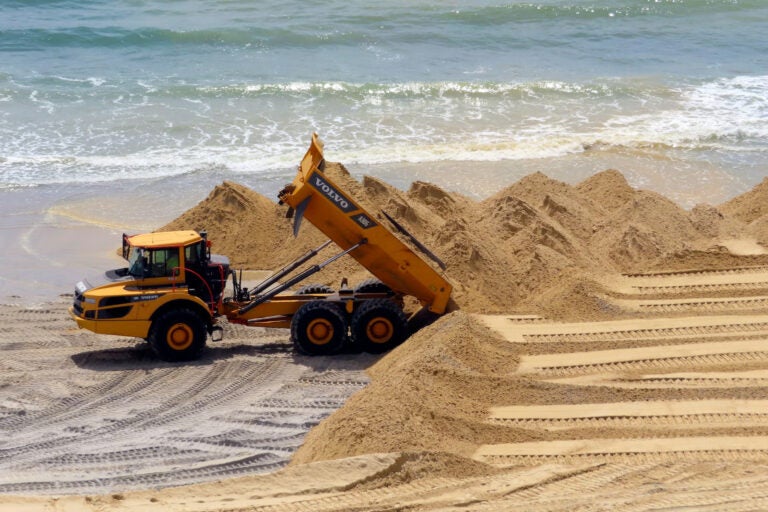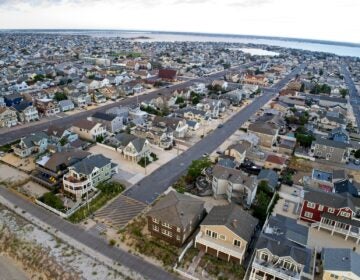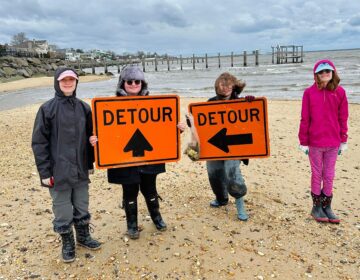Federal funding freeze stalls New Jersey beach replenishment projects
The stalled beach nourishment projects come after a new study found that coastal flooding could become the norm in the near future.

FILE - A load of sand is dumped on the beach in front of the Ocean Casino Resort in Atlantic City, N.J., Friday, May 12, 2023. (AP Photo/Wayne Parry, File)
From Camden and Cherry Hill to Trenton and the Jersey Shore, what about life in New Jersey do you want WHYY News to cover? Let us know.
The Jersey Shore’s wide, sandy beaches anchor family traditions, fuel local economies and protect communities from storms. But those same storms also routinely tear down the shoreline, forcing many communities to rely on beach replenishment projects every few years.
After Congress eliminated federal beach nourishment funding in the fiscal year 2025 budget, there is rising concern among Jersey Shore residents and local officials about how to pay for replenishment projects. Coastal towns are scrambling as lawmakers search for leftover dollars within the U.S. Army Corps of Engineers’ budget.
Only four of the 12 federal spending bills have passed so far. The Energy and Water bill, which funds the Corps, remains under a continuing resolution through Jan. 30, 2026. The House version sets aside about $25 million for beach work, and the Senate draft has not yet been released.
New Jersey Department of Environmental Protection officials said the loss of key federal dollars threatens the long-term work that protects coastal communities from storms and flooding.
“Army Corps does not typically step in to implement short-term repairs of beaches, nor does the DEP directly implement short-term repairs,” spokesperson Caryn Shinske said. “Local communities, working with the DEP under local beach maintenance projects, are responsible for these repairs.”
State, local officials search for alternative solutions
At a recent meeting, Upper Township Mayor Curtis Corson said local officials met Yodock Simmons Construction & Environmental Solutions representatives to discuss possible erosion control methods. Corson said they are investigating a system used off the coast of Florida in the Gulf of Mexico, where plastic W-shaped barriers are filled with sand and placed offshore “for the wave to hit and knock down the sand.” He said the system has never been used in the Atlantic Ocean.
Ocean City resident Jamie Adams-Ford shared she is not very hopeful.
“I understand that there are pros and cons for beach replenishment. Obviously, our barrier island is tourism-based and benefits from wide beaches that also serve as protection to property and businesses,” Ford said. “But it is a very costly and temporary fix. Based on how hard we’ve been hit by erosion in Ocean City by the last two nor’easters, it seems like replenishment is our only defense against future storms.”
New Jersey’s Shore Protection Fund provides $25 million annually to protect coastal property from damage, with a preference for projects that include federal matching dollars. Gov. Phil Murphy proposed raising the fund to $50 million in his 2024 budget, but it remains unchanged. New Jersey Senate Bill 2011 would also expand the fund, though it is currently stalled. Assemblyman Antwan McClellan, R-Ocean City, said lawmakers are also exploring new approaches to shoreline protection.
“We’re in it in 2025, and we’re still using old-school methods to replenish beaches,” he said. “We have been talking about what can be done and looking into ideas of how we can protect our beaches, and coming up with new ideas as opposed to just dredging.”
Rising sea levels are an increasing threat for shore towns
The desperate search for solutions comes as tourism continues to drive the region’s and New Jersey’s economy. The Garden State welcomed a record 123.7 million visitors in 2024, with spending topping $50.6 billion for the first time, according to an economic report. Cape May and Atlantic counties together represent nearly one-third of the state’s tourism economy, drawing more than 36.08 million visitors in 2024. Cape May County alone generated $8.1 billion in visitor spending and hosted 12.11 million visitors.
But that economic engine is increasingly vulnerable. A new report from a Rutgers-led New Jersey Science and Technical Advisory Panel warns that sea levels are rising, setting up a future where coastal flooding could become a regular reality. Driven by melting ice and sinking land, Atlantic City’s tide and water levels have been climbing by about 1.7 inches since 1912. That rise has already pushed minor flooding from less than once a year in the 1950s to about a dozen times annually today.
Looking ahead, the panel projects up to 1.7 feet of sea level rise by 2050. Atlantic City could see between 29 and 148 flood days a year, putting pressure on homes, roads and local infrastructure.
What are the solutions?
Scientists say reducing greenhouse gas emissions remains central to slowing sea level rise.
“So long as humans are increasing the amount of greenhouse gas emissions in the atmosphere, global warming will increase, and so too will the rate of global sea level rise,” said
Robert E. Kopp, director of the Megalopolitan Coastal Transformation Hub at Rutgers University.
NJDEP officials noted that displaced sand is sitting offshore and could return naturally if the season stays calm. The state is urging towns to move quickly on local maintenance and consider self-funded stopgap projects as it continues to push Congress to restore federal support.
“Municipal public works crews are very experienced in understanding these dynamic processes while they move sand around to maintain protective beach elevation profiles and stable dunes,” Shinske said.
Federal officials representing New Jersey are also seeking answers.
A spokesperson for U.S. Sen. Cory Booker said in a statement that his office remains committed to securing the necessary federal investments to fund critical Army Corps of Engineer projects and “will continue to advocate for appropriations that will deliver for every single New Jerseyan––from Cape May County to Sussex County and everywhere in between.”
U.S. Rep. Jeff Van Drew and U.S. Sen. Andy Kim convened meetings separately with local and state officials.
“Taking away this funding is just devastating for our shore towns; it’s something I’ve heard from local mayors and people across these communities. It’s a problem that impacts everyone, and it’s going to require everyone working together to find a solution,” Kim said in a statement.
Other funding options
The American Coastal Coalition said it has been seeking $200 million for beach nourishment projects nationwide, enough to complete all scheduled work for 2025 and 2026. They note that figure represents 2.3% of the Corps’ $8.68 billion budget.
“It is rare to see the state doing its own project without a cost share partner. What options does N.J. have? None, really, without the federal government,” said Dan Ginolfi, executive director of the American Coastal Coalition, a nonprofit advocacy group for coastal communities and beaches.
Local lawmakers say the state may have to rely more heavily on its own revenue sources while they press federal officials to restore funding. McClellan said that state occupancy tax revenue can help supplement what the federal government does not provide. Chamber of Commerce officials have said that beach counties generated $53.13 million, or 27.46% of the statewide occupancy tax collected in 2024.
“It doesn’t just have to be used towards marketing. If you don’t have a beach to market, then what do you have?” McClellan said. “I don’t know if the state can properly fund it itself while we work to try to negotiate with our federal partners to get those dollars back.”
He added that the issue extends far beyond summer tourism.
“I think that people need to realize it’s not just for recreational use, it’s coastal protection,” he said. “It protects our coastal community; it is a livelihood issue for us.”
Upper Township Administrator James W. Van Zlike echoed the sentiment.
“Doing nothing for 2026 is not a realistic option. Strathmere already faces chronic erosion and storm vulnerability,” he said. “Further loss of beach width would affect public access, emergency response and public safety, and increase risk to public infrastructure and private property. It would also have economic consequences for the tourism driven regional economy.”
WHYY News is partnering with independent journalists across New Jersey to spotlight the people, communities, cultures and distinctive places that shape the Garden State. This work is made possible with support from the Geraldine R. Dodge Foundation.

Get daily updates from WHYY News!
WHYY is your source for fact-based, in-depth journalism and information. As a nonprofit organization, we rely on financial support from readers like you. Please give today.









